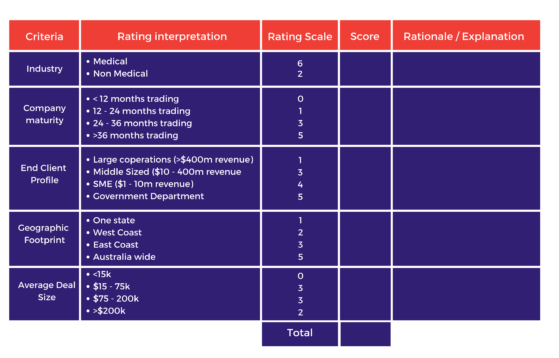In our experience 70-80% of all sales opportunities that are lost in the later stages of the sales process are avoidable and represent an unnecessary level of wasted sales professional time and effort.
This waste is caused by a number of things including:
- A lack of rigour in the qualification of pipeline opportunities in the earlier stages of the sales process.
- A lack of clarity in terms of what characteristics the sales professional should be looking for in their prospects.
- Not having a consistent way to rate and rank the sales opportunities that a sales professional finds, so that they spend more of their time with those that are most winnable.
One of the most effective things that you can do to reduce this level of waste and late stage loss is to define something called an “ideal prospect profile” because it will help you to target the right types of prospects from the start.
You can define the ideal prospect profile for your business by following four simple steps:
1. Identify your 5-10 best / most important / most valuable current clients.
The key thing here, is to focus on your current clients, because they have already assessed your business and offering and have purchased from you. This step allows you to answer the question “What types of customer would we like more of?”
2. Identify what characteristics these “best clients” have in common
This could be factors such as their size, business maturity, the average deal size or range of products that they purchase, their geographic location, industry or sector, their willingness to partner and collaborate or their potential to grow. This step allows you to answer the question “What characteristics should we be looking for in our prospecting?”.
3. Identify the typical range of values for each characteristic for your most valuable and your least valuable clients.
The next step is to take each characteristic in turn and identify the typical range of values for your best clients, worst clients and those in between. For example, if the characteristic is “industry”, you might find that your best clients all come from industry 1 or 2 because they have the best fit with your products and services. You might also find that you least attractive clients all come from industries 3, 4 and 5, because they have a relatively poor fit and this creates challenges. You may then discover that there are a number of other industries that fall in between these best and worst, that should also be reflected in your ideal prospect profile.
4. Design a scorecard
Using the values that you identified in step 3, design a scorecard that enables you to rate and generate a lead score for each new sales opportunity that you find.
This lead score will reflect how closely any new sales opportunity matches the profile of your best clients. The higher the score, the better the match. The better the match, the higher the priority that should be placed on that opportunity. Equally, the lower the lead score, the poorer the match and so the less attractive the opportunity.

When you get the definition of your ideal prospect profile right and then use it consistently to prioritise and qualify every opportunity that you find, it will deliver a number of benefits:
- You will be clearer and more confident in the types of sales opportunity to target and look for in your prospecting.
- You will become more efficient and productive because you spend more of your valuable time with prospects that are more attractive and more likely to buy.
- Your marketing, messaging and sales collateral can all be more effectively tailored and targeted, so that it resonates and has a greater impact.
- You will be able to reduce your late stage losses in your pipeline by up to 50%.
Whilst this is quite a simple and straightforward process to work through, in our experience there are still many sales professionals and sales teams that do not yet have a clearly defined ideal prospect profile.
How we can help
Get in touch with us today to develop your sales capabilities, designed to empower your people to sell with confidence.


